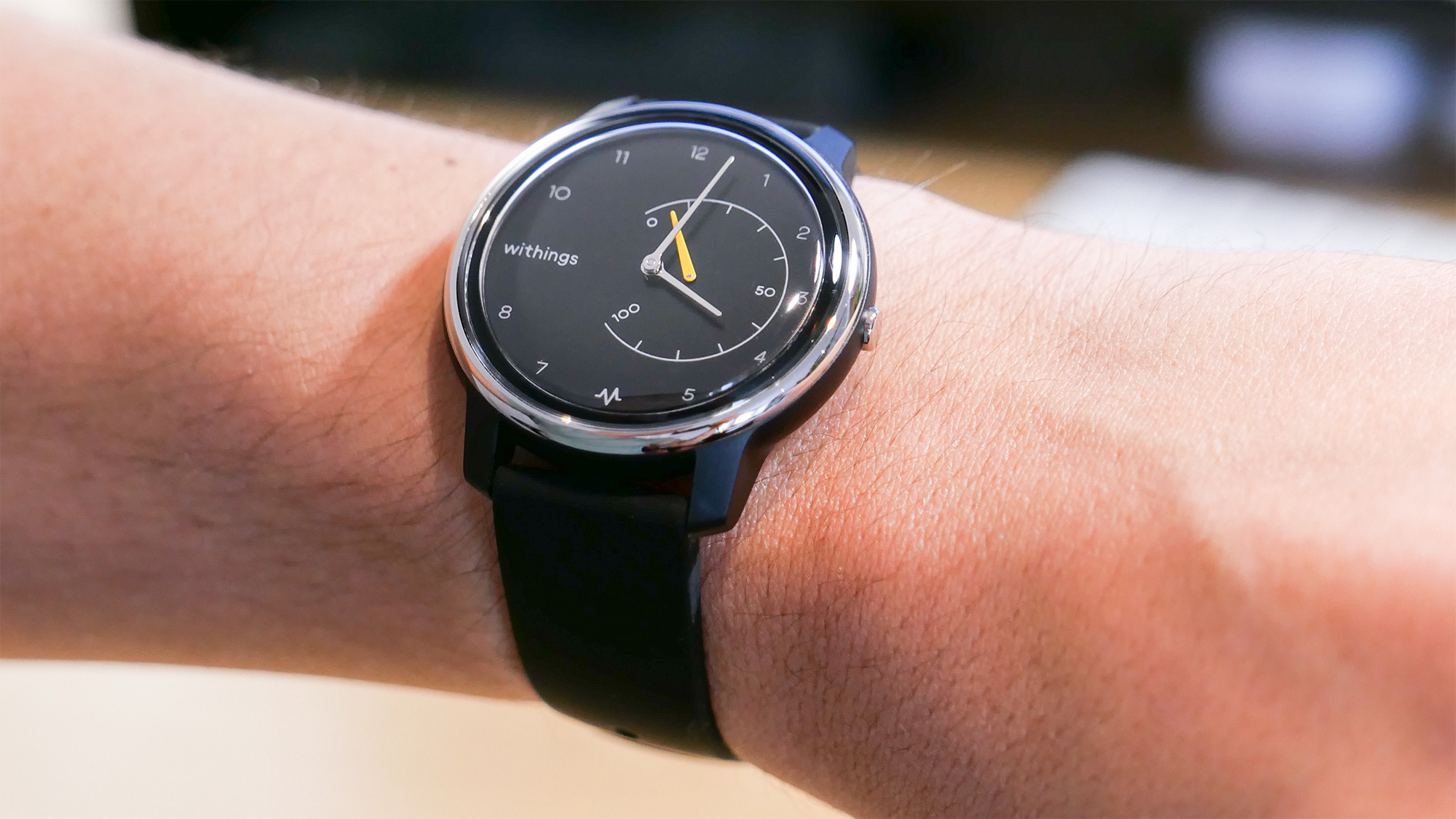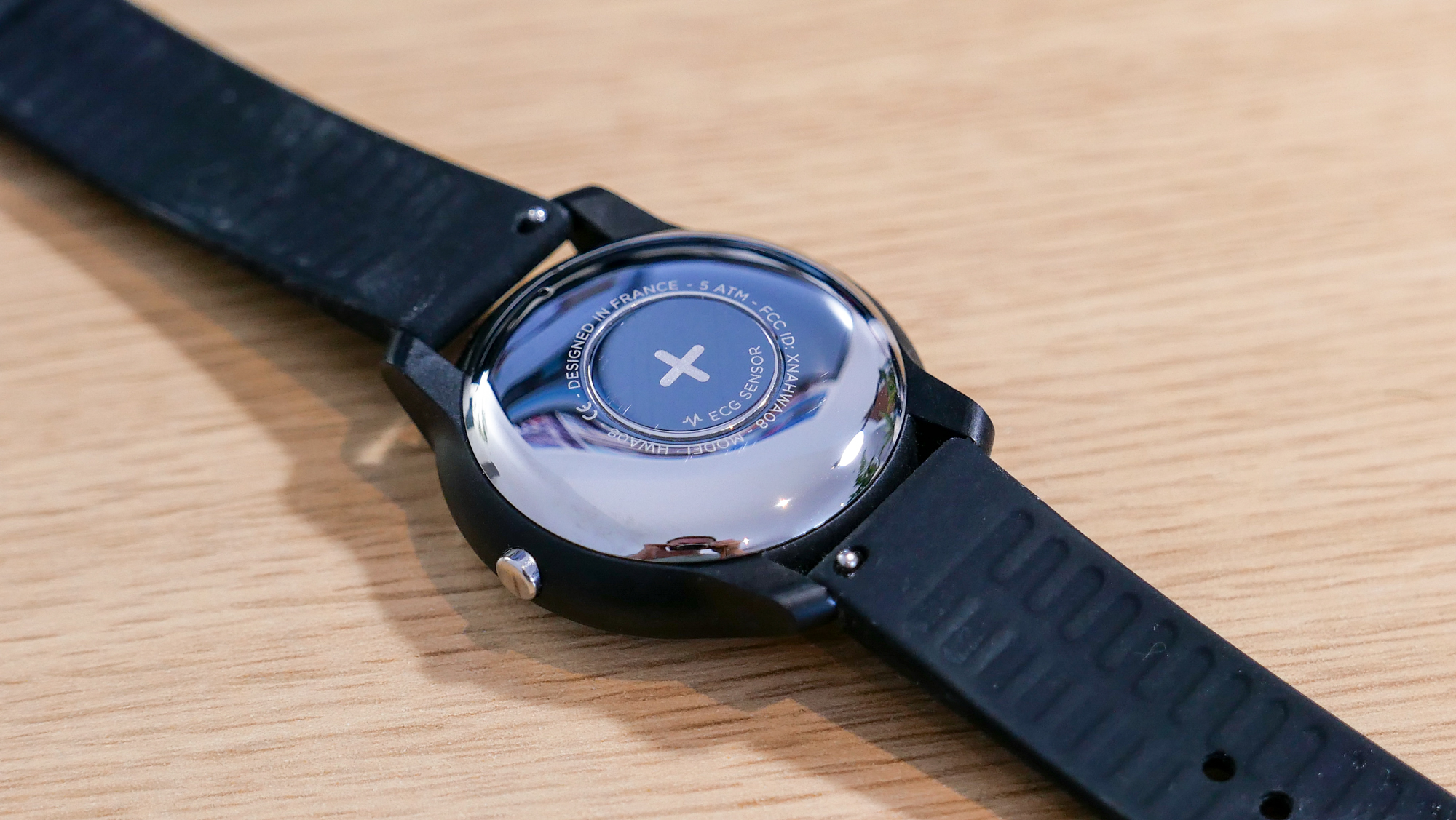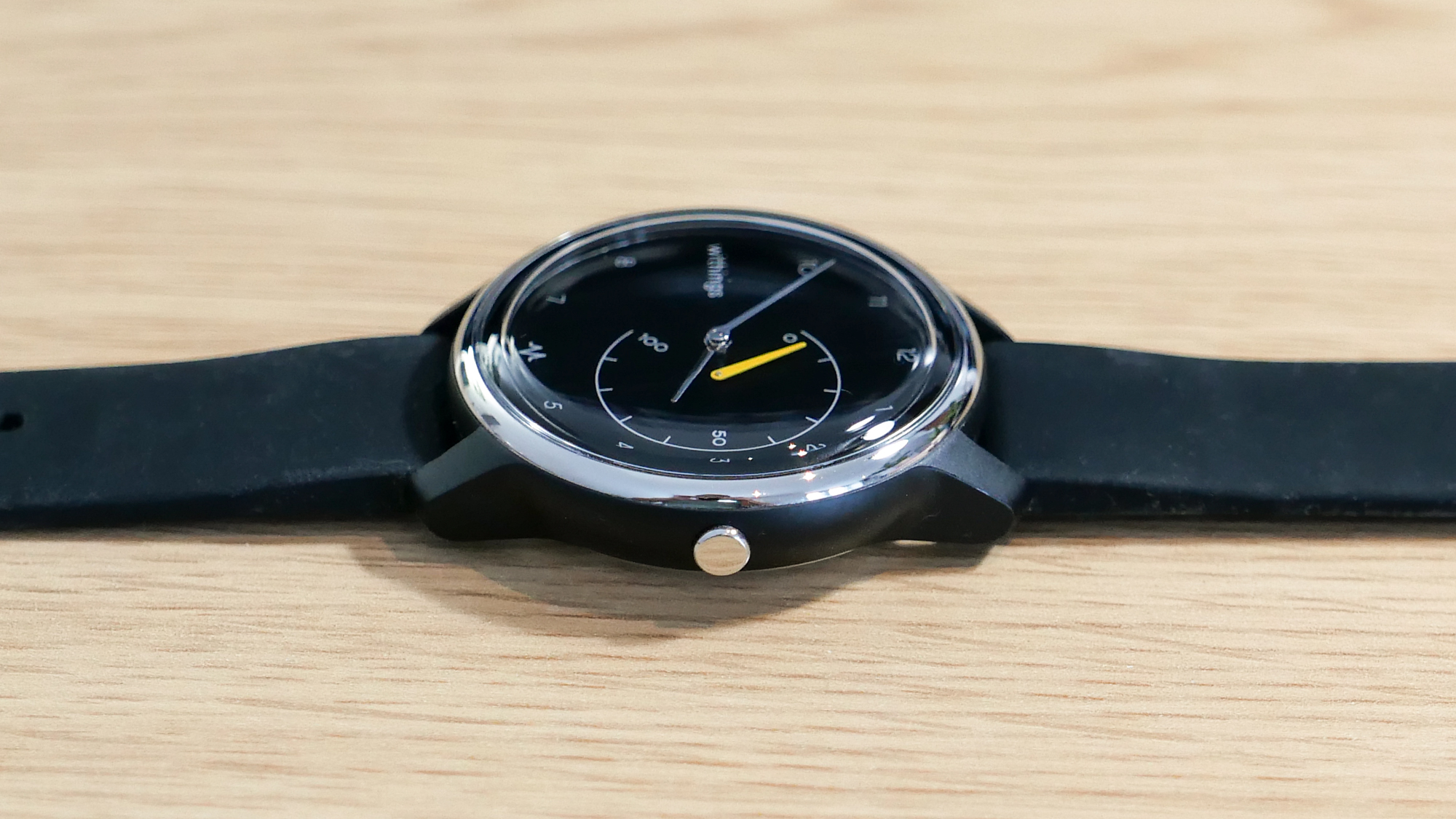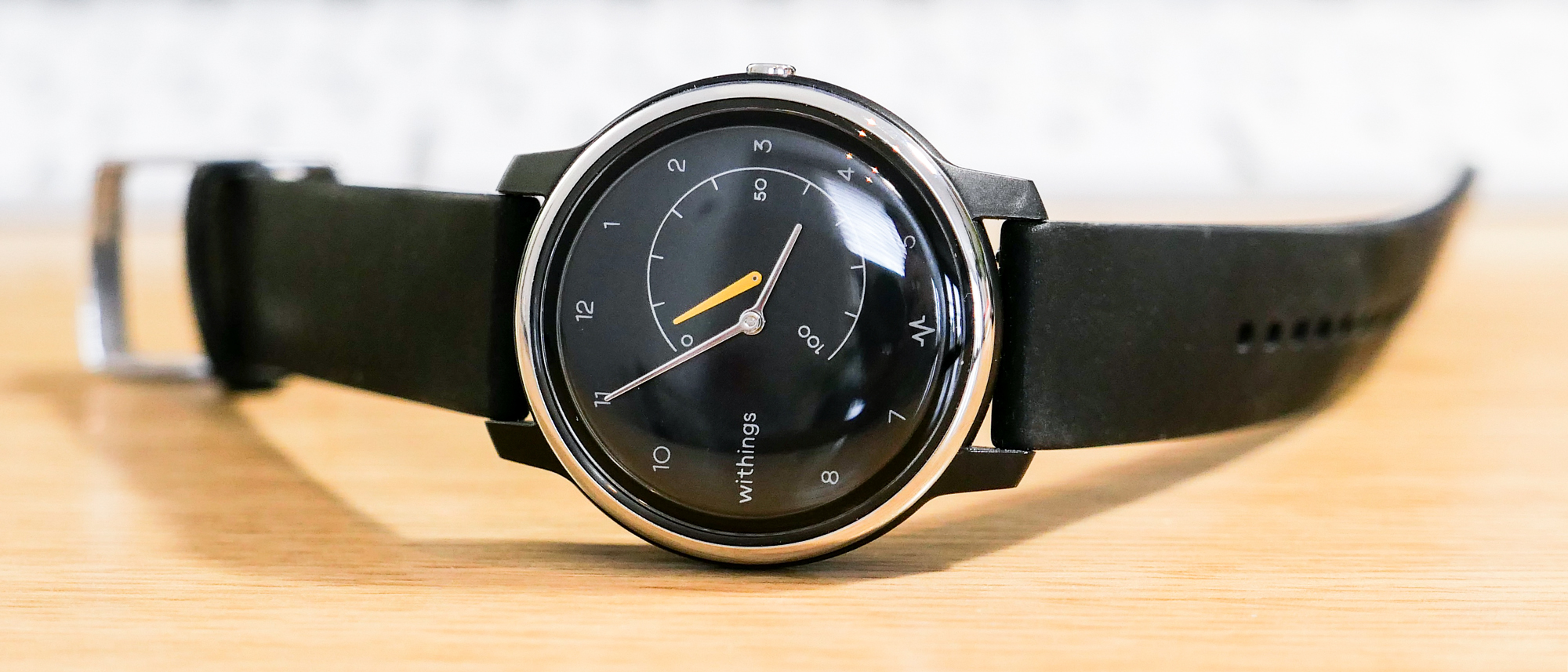TechRadar Verdict
The Withings Move ECG is a stylish and affordable hybrid smartwatch which tracks walking, swimming and exercise. Crucially, it can also take an electrocardiogram (ECG) and warn you to the symptoms of atrial fibrillation. The Move ECG is stylish and available in a wide range of colors, but cost-cutting is evident in the use of plastic and lack of continuous heart rate monitoring.
Pros
- +
Stylish design with several color options
- +
12-month battery life
- +
ECG function could save your life
Cons
- -
Use of easily-scratchable plastic
- -
Heart rate only taken alongside ECG
- -
ECG doubles the price
Why you can trust TechRadar
When the Apple Watch Series 4 landed in 2018, it caused a stir for being one of the first (and unquestionably the most high-profile) wearable to offer an ECG app. Short for electrocardiogram, an ECG records the electrical activity of your heart to indicate whether or not you might be suffering from atrial fibrillation (ABfib), a heart problem experienced by a quarter of the population at some point in their life, and which can lead to life-threatening complications.
While the Apple Watch Series 4 includes a whole lot more for its £399 / $399 / AU$649 price tag, that’s still a hefty price to pay for what could be a genuinely life-saving piece of technology. Thankfully, there is now a far more affordable way to keep a regular check on your heart - with the Withings Move ECG.
Although not a fully-fledged smartwatch like the Apple, the Withings Move ECG is a hybrid. This means it has analog dials and no display, but includes accelerometers and a Bluetooth connection for tracking movement, steps, swimming, exercise and sleep, then presenting the data on the free Withings Health Mate smartphone app, available for iOS and Android.
The Move ECG is, as you might expect, very similar to the Withings Move, but with the addition of the ECG function. The newer model lacks a heart rate sensor, but you could argue an ECG app is more important than merely knowing your heart rate; the former is a fitness stat, while the latter relates more directly to your underlying health.
Withings Move ECG price and release date
- How much does it cost? £129.95 / $129.95 / Approximately AU$190
- When did it come out? September 2019
The Move ECG was first shown off at CES back in January 2019, but at the time it didn’t yet have the certification required to use its ECG function. This has now been obtained, and the Move ECG is on sale now in the US, UK and Europe for £129.95 / $129.95 (around AU$190).
At the time of writing in early-September 2019, orders placed through the Withings website should arrive in two to three weeks.

Design
- Classy, traditional watch design
- Smaller than most hybrid smartwatches
- Plastic could scratch easily
If you have used previous Withings hybrid watches, then the new Move ECG will be immediately familiar. It offers the French company’s house style of a compact case, domed front, simple and uncluttered face, and a second dial for showing your daily step count.
There is a single button at three o’clock where the crown of a mechanical watch would be. A short press of this button activates the ECG function, and a long press tells the watch to start recording an exercise session.
The sides of the case are plastic, while the bezel and rear are a classier stainless steel that can be used to measure your heart’s electrical activity when touched. The button is also stainless steel, and so too is the buckle.
Withings includes a silicon sports-style strap with the Move ECG, which attaches uses industry-standard quick-release lug bars. This means it can be removed easily and replaced with any 18mm strap. The company itself offers a good range of options here, and the black dial of our review sample means it can be matched smartly to straps of almost any material and color.
As well as the time, shown with a pair of stainless steel hands and numbered indices, the Withings Move ECG has a second dial on its face with a contrasting yellow hand. This sweeps from zero to 100, indicating what percentage of your daily step target (set via the smartphone app) you have completed.
This yellow hand also acts as a 30-second countdown timer when you activate the ECG function.
Overall, we like the design of the Withings Move ECG. The watch is smart and subtle, can be worn with just about any strap you like, and blends in neatly with any dress style - unlike other wearables on the market. The compact size means the Move ECG (like most other Withings) doesn’t draw unnecessary attention to itself, and it hides its technology in a way fully-fledged smartwatches rarely achieve.
The Move ECG is light and comfortable, with a dozen or so holes on the strap for finding the perfect fit. It was never an annoyance to wear - even when tracking our sleep at night - and the ECG hardware on the back doesn’t protrude at all. The new feature has zero aesthetic and ergonomic downsides.
Our only criticism is the use of plastic on its front instead of glass or sapphire crystal. Although our review watch remained scratch-free for the week we used it, we wouldn’t expect this to last. This is fine for the £60 Move, but when paying £130 for the Move ECG, we’d like to see glass instead of plastic.

Fitness and sleep tracking
- ECG function
- Step, sleep and exercise tracking
- No continuous heart rate sensor
Although a perfectly decent timepiece, the Move ECG really reaches its stride when used as a health and fitness tracker. The watch is always monitoring your movement, automatically counting steps during the day and sleep each night. Withings says the Move ECG can record over 30 different types of exercise, and everything is logged in the company’s Health Mate smartphone app.
The headline feature is, of course, the ECG function. This works in a similar way to that of the Apple Watch Series 4, whereby the wearable touches one side of your body via the back of its case sitting against your wrist, and the other via the finger of your opposite hand. By touching the wrist of one arm and the fingers of the other, a circuit is created and the watch can record the electrical activity of your heart.
The Health Mate apps talks you through what the ECG function can and can’t do when you first set up the watch. It is important to remember that ECG smartwatches cannot detect heart attacks, and the data they provide should be used in addition to - not instead of - advice from your doctor.
To take an ECG, briefly press the button. The watch then vibrates for a moment and the step-counting hand turns to 100; you then place your thumb and index finger on the metal bezel of the watch case, and keep still while the hand counts down from 30 seconds to zero. The watch vibrates again to indicate that the ECG is complete, and the data can be viewed instantly in the Health Mate app.
The app tells you right away if the ECG reading is normal, or shows signs of ABfib, and the data it collects can be turned into a PDF, ready to be sent to your doctor.
Withings has opted not to fit the Move ECG with a traditional heart rate sensor. This means you can’t use the watch to continuously track your heart rate, but you can still get a beats-per-minute reading each time you perform an ECG. This figure is shown alongside the ECG data in the Health Mate app.
The lack of constant heart rate reading also means there’s no way to see how quickly your rate returns to normal after exercise (a good indication of overall fitness), and no way to attain a VO2 Max estimate. Both of these stats are provided by other Withings wearables, like the Steel HR Sport hybrid watch, but they do so at the expense of cost and battery life.
The Move ECG has an altimeter for measuring the number of staircases climbed each day, but lacks its own GPS chip for tracking outdoor runs. Instead, the watch can use your smartphone’s GPS via its Bluetooth connection.
Sleep tracking is automatic, activating each night and giving you a breakdown of your sleep in the Health Mate app the following morning. The watch uses movement to sense when you are in the different stages of sleep, and plots this against time. This works in a very similar way to Withings’ dedicated sleep tracker, the Sleep, but does not track your heart rate, snoring, or breathing disturbances.
The Move ECG’s sleep tracking is fairly primitive compared to wearables with continuous heart rate sensors (or dedicated trackers fitted under your mattress), but it still provides a decent and fairly accurate overview of your nightly slumber.
Battery life
- 12-month battery life
- Uses standard CR2430 battery
Being a hybrid smartwatch, the Move ECG’s battery life is measured in months instead of hours or days. In fact, the Bluetooth chip, movement sensors and ECG function demand so little energy, the wearable takes a regular CR2430 watch battery, which Withings claims lasts for 12 months.
This will depend on how you use the watch, and those who record daily exercise sessions should expect to see shorter battery life than those who are less active. But either way you cut it, roughly 12 months is very good for a wearable.
Unlike Withings watches which have rechargeable batteries, like the Steel HR Sport, the Move ECG’s remaining battery life is not shown in the Health Mate app.

Interface and app
- Health Mate app is clean and simple to use
- Data from multiple devices is stored in one place
As with all other Withings devices (and those branded as Nokia Health in the past), data captured by the Move ECG is logged by the Health Mate app, which is free and works on iOS and Android.
Designed to be a one-stop-shop for health and fitness data, Health Mate syncs with the watch via Bluetooth as soon as the app is opened. The main ‘Timeline’ interface shows your daily steps, percentage of target complete, and floors climbed (thanks to the watch’s altimeter). The Timeline also shows every ECG you have taken with the watch, along with your heart rate at that moment. As we said earlier, this wearable does not monitor your heart rate constantly, during sleep, or while exercising.
The app provides a daily and weekly overview of how you’ve done, showing clearly when you made and missed your daily step goal, your total distance walked and elevation climbed for the week, and averages for both weekdays and the weekend.
For sleep data, the Health Mate app awards a score out of 100 each morning. This is calculated by taking into account the total time you spent asleep, but also the depth of your sleep, how much time you spent in REM, and how many times your sleep was interrupted during the night. Your sleep ‘regularity’ is also taken into account, which looks at the average time you go to bed and wake up each day, then you are rewarded a score based on your ability to stick closely to this average.
The Dashboard page of the Health Mate app is where you find an overview of all data it has access to. This includes data captured by the watch (and any other Withings devices you have), and also data entered manually, like your gender and weight. Because we also use a Withings smart scale and sleep tracker, our Dashboard shows body fat, sleeping heart rate, muscle mass, body water and body mass, along with the ECG readings taken by the Withings Move.
A number of health and fitness programmes are available to join in the app. These are free and include an eight-week course designed to improve your sleep, plus a five-day program that analyzes blood pressure (so long as you have the Withings BPM Connect). There’s also a 21-day mindfulness course made in collaboration with the Petit BamBou meditation app, and an eight-week course to educate you on body composition and ways to lose fat. Finally, there’s a pregnancy tracker which works with Withings’ range of smart scales.
The Move ECG’s silent alarm is set within the app. This vibrates to wake you up and can be set to go off when your are least asleep, within a user-defined amount of time of your actual alarm. Say you set the alarm for 6am, but with a 15-minute window; if the Move ECG detects you waking up at 5:50am, it will vibrate the watch.
Setting the time of the Move ECG is done here too, but the watch generally uses your phone to stay on the right time. That way, it automatically adjusts for daylight savings hours, and when you travel to a different time zone. That said, we found it was slow to adjust when traveling unless we briefly opened the Health Mate app, then the time changed instantly.
Verdict
The Withings Move ECG makes for an interesting proposition. It follows much of the usual recipe - a stylish and simple analogue watch with exercise and sleep tracking - but also adds an ECG function.
This puts the Move ECG in a position where it takes the regular Move, a budget £60 hybrid watch, and blesses it with a feature most famously used by the Apple Watch Series 4 and Series 5, a pair of flagship, full-fat smartwatches. The Withings therefore takes features from the top and bottom of the market, and marries them to create a £130 wearable.
There are two face color options, each with five straps to help you buy a watch that suits your style, and the metal bezel used by the ECG function adds a touch of class to proceedings. We’re particularly keen on the white case and face with blue strap.
The Move ECG is let down by its lack of continuous heart rate monitoring, as this stat is only given when performing an ECG, and we worry that the plastic in place of glass or sapphire crystal will scratch easily.
Who’s this for?
There’s no denying the usefulness of having an ECG device on your wrist. If you feel you could be more susceptible to atrial fibrillation than most, then it’s tough not to argue in favour of buying the Withings Move ECG. If the Apple Watch Series 4 or 5 is out of your budget, and ECG support is high on your list of priorities, then the Move ECG could well be the wearable for you.
Should you buy it?
If you feel you need to keep tabs on your heart’s health, then the Withings Move ECG is an affordable way to put an ECG on your wrist. It also acts as a classy and subtle watch which tracks your exercise, swimming, sleep and daily steps.
Add in several free health and fitness programs in the Health Mate app, plus the silent and dynamic alarm function, and you have a feature-packed hybrid smartwatch.
The ECG function adds a large price premium over the £60 Withings Move, so buyers should really ask themselves if taking an ECG is really what they need from a wearable. That said, £130 still isn’t much for the peace of mind an electrocardiogram could give - and the knowledge that being alerted to the symptoms of AFib could genuinely save your life.
This isn’t a fully-fledged smartwatch - far from it - but it’s a well-priced wearable which covers the basics, yet also packs a top-tier feature.
First reviewed: September 2019
Alistair Charlton is based in London and has worked as a freelance technology and automotive journalist for over a decade. A lifelong tech enthusiast, Alistair has written extensively about dash cams and robotic vacuum cleaners for TechRadar, among other products. As well as TechRadar, he also writes for Wired, T3, Forbes, The Independent, Digital Camera World and Grand Designs Magazine, among others.

